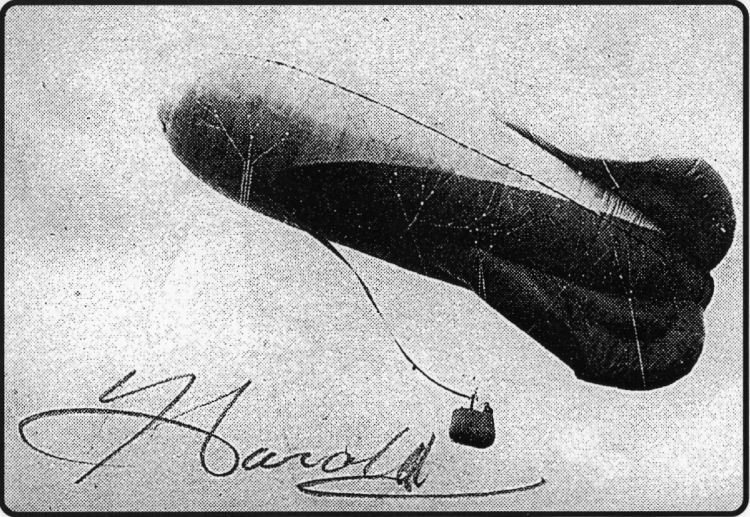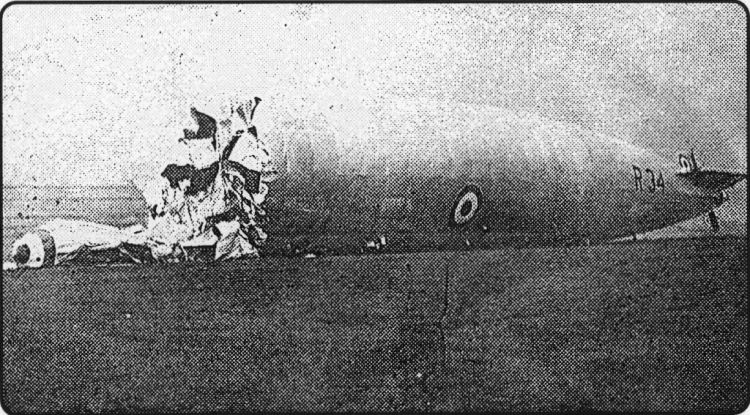
Published 4 January 2001


Silver Queens
MEMORIES of Capel Airship Station in the First World War, with its massive
hangars and their four or five kite balloons and airships which were used to
hunt enemy submarines in the Channel, were revived by a collection of old
pictures shown to me by a Memories reader in Folkestone.
Hundreds of thousands of troops crossed the Dover Strait from Folkestone en
route for the Continent to fight in the First World War in France and
Belgium. And the role of the airships, or 'blimps' was to spot the enemy's
U-boats which would otherwise have sunk those troopships.
So successful were they that it is claimed there were few if any losses due
to menacing submarines while patrols were made.
A silver paint finish earned some of them the nickname of 'Silver Queens.'
The photographs belonged to the late Harold
'Cock' Scowen, uncle of Derrick Lawson. Born in Dover, Derrick now lives in
Lynwood, Folkestone.
Harold, a member of a large Folkestone family, served in the Royal Naval Air
Service which manned the airships at Capel, later moving to Tregantle, in
Cornwall, where he afterwards decided to settle. And it was from Cornwall
that Barbara Davis (nee Scowen) sent the pictures to her cousin Derrick
Lawson.
Derrick says his uncle explained his nickname by saying his mother Beatrice
Scowen's maiden name was Cockerton.
Derrick, 73, was the son of Ernest William Lawson, who began work on the
railways at 13 and was at one time based in Dover.
Derrick himself used to work at Ashford Railway Works.
He likes to talk of his ghostly experiences and of how his Uncle 'Cock'
Scowen once got 'tippley' - which led his fellow airmen at Capel to play a
practical joke on him. The year was probably 1915.
And Derrick has a great souvenir of that prank - a picture of an airship,
signed by his uncle, in which Harold one day came to his senses only to find
himself in the balloon's basket flying high over the Channel!
Remarkable man’s ‘Grand’ scheme
FROM The Grand, on The Leas, I have heard from Michael Stainer, who was
particularly interested to see a mention in Memories back in November of
Daniel Baker, whose grandfather had been a leading light in the Folkestone
Water Company for SO years and also served as mayor of the town.
Michael says Mr Baker's life-size mayoral portrait hangs in The Grand. "This
remarkable man had had a busy year.
On March 23, 1899 the Alderman deposited his plans for Tha Grand with the
Council. They were approved on March 25 and he started work on March 28. The
building was topped out in 1900. It was said to be the first large
reinforced concrete building in the World, and among other remarkable
features, has a steel frame and insulation filled cavity curtain walls.
"He was not the only pioneer in Folkestone at that time; the town is
littered with world firsts.
TV ‘first’
"The first pillar box had been installed in Sandgate Road, and the first
telephone kiosk - in rustic style - was installed on The Leas opposite The
Grand."
Then, says Michael there was Samuel Plimsoll, a Folkestone resident, who was
chief promoter of an Act of Parliament which gave us the safety loading line
for cargoes on merchant ships, called the Plimsoll Line.
"John Logie Baird had a shop in Guildhall Street from which the first
television pictures were transmitted - to my grandfather John Stainer’s
chemists shop in Sandgate Road, where he conducted many of the early x-ray
experiments.
"He, too, was mayor a number of times, and Chairman of the Folkestone Water
Company.
"As Michael Caine, aka Sir Maurice Micklewaite, would say: 'Not a lot of
people know that' "And he, too, made his first stage appearance in
Folkestone at - you've guessed - The Grand, as did Robert Morley and David
Tomlinson," said Michael.
HAROLD 'Cock' Scowen, a lonely airman peers over the edge of the basket of a
kite balloon high over the Channel after his Capel airship station
colleagues played a prank on him during his service there - after a 'good
night out!'
Once safely back on the ground he evidently saw the joke and signed
1919. The nose appears to have met either with a serious accident or to have
been deflated after a puncture perhaps. The question is, could it have been
taken in Capel? Derrick Lawson is investigating.
Incidentally it is said the nickname 'blimps' for airships came about after
an incident in one of the hangars at Capel. When a bigger airship came along
men had to excavate the floor of the hangar to get it inside.
A high platform was constructed to enable the top of the airships to be
inspected, And, when someone leaned over and touched an airship the sound
was described as a 'blimp' - well that's the story, anyway!
the photographic memento of the event!
Tented camp
Other souvenirs of his uncle's airship days include several snaps of groups
of officers and men (some of whom later became RAF fliers,) one or two
showing airships or hangars, of which there were several, and personnel,
with tents in which they slept at the Capel station, while officers took
over Abbotts Cliff House.
One picture shows R-34, Britain's first airship to make a there-and-back
crossing of the North Atlantic in
uiki
 |
Squabble over £10 cost of welcome to the Earl
•I Q/\«t AS THE year 1900 drew to a close the V JJierald editor was
calling for a united effort to “mark the departure of the Old Century"
suggesting a big collection to boost funds of the Victoria Hospital and
for a commemorative plaque to be put up on the building. The birth of a
new century was celebrated with a Grand Ball at Shorncliffe Camp, but
with our troops still facing the enemy Boers In South Africa there was a
degree of modesty over the amount lavished on decorations. There were
toasts during the night to comrades on active service but a good evening
of dancing followed, although the fair sex somewhat outnumbered their
potential partners due to the war. The Town Council did themselves no
favours by squabbling over the cost of presenting to Earl Radnor an
illuminated ‘address' offering an official welcome to the town after he
succeeded to his late father's title, as Lord Radnor. This was on his
return to the UK after service in Africa during the Boer War when he
risked his life for Ms country and was struck down by an illness that
could easily have killed him. The trouble was a storm In a teacup over
the legality of the costs -a mere £10 - being met from the rates.
|
Calls for direct main line railway link to Hythe town
«f QO/5AN ANONYMOUS Hythe reader was JL*7«>Osuggesting Hythe should be
served by trains down a new track from Sandling Junction via Brockhill
Valley, with a station near Red Lion Square and running along the north
bank of the Royal Military Canal to Hastings via Appledore^ Dymchurch
and Romney. The new service would open up the district and the Roughs
and plateau at the top would become another Leas, like that at
Folkestone. The Folkestone Bowling Club, hearing that South Africa was
due to send a touring side to the UK In 1926, sent an invitation to the
team to come and play in Folkestone. This was because the secretary of
the touring side was Edward Snell, of Pretoria, who was a native of
Folkestone. Celebrating their Diamond (60th) Wedding Anniversary were Mr
& Mrs William Holdstock, who were stalwartsof the local Congregational
churches some 50 odd years. Remarkably, William was still working for
wine merchants JH & J Brooke, in Sandgate Road to whom he had given
between 60 and 70 years service! The Herald reported that Dover Harbour
Board had decided to seek Parliamentary powers to dose the western
entrance of the harbour to create more comfortable conditions inside in
stormy weather for Continental and commercial steamer traffic.
|
Duchess to visit camp as troops go overseas
* AM THE DUCHESS of Kent was due to visit JL«/9JLShorncliffe Camp, as
Colonel-in-chief of the Queen’s Own Royai West Kent Regt, the 1st Bn of
which was due to leave on overseas service. The Mayor of Folkestone and
the chairman and vice-chairman of the Town Council's highways and
building committee were appointed to discuss with the company directors
a proposed merger of the Dover and Sandgate Water Companies. There were
hopes of an end to the risk of young women being molested with the
introduction of a lighting scheme for the East Cliff promenade.
Methodist stalwart in the districts William Hatchard, 87, was being
mourned. He preached over 1,000 sermons, reaching that landmark at
Lyminge in July 1943. Commandant of Sandgate Police Training Centre,
Chief Supt R Roberts was made an MBE in the New Year's Honours List. Our
old midweek paper, the Folkestone & Hythe Gazette printed a picture of
Sandgate Road and Holy Trinity Church, Folkestone, dating from about
1870. which was before the church steeple was built and housing
development in the street had hardly begun. Bus fares were set to rise
warned the East Kent Road Car Co’s chairman who spoke of heavy extra
taxes on fuel. Extensive alterations to Sandgate’s East Kent Arms were
approved by magistrates.
|
Crisis in health service as doctors get tough on hours
if q<7£%JUNI0R doctors fed up with working up to JL«7 f OllO hours a
week, sometimes more, at the Royal Victoria Hospital were involved in a
dispute with their employers. They and other doctors restricted their
hours to 40 a week, but they pledged they would not stand by and allow
patients to; suffer. The doctors lived in at the hospital and said there
would be at least one off-duty man available at all times to deal with
emergencies. Apart from the hours they were complaining that no overtime
payments were made until they had exceeded 80 hours. Some of them were
dropping on their feet with exhaustion, they complained. The conditions
affected both their family and social life. (Just 25 years later this
writer's son resigned from his job as a doctor after eight years for
the same reasons, to seek a new career..... Another
doctor lost to the national health service!) Member of a family of
circus artistes Mrs Emily Reaney, whose grandmother had the rare
distinction of having walked a tightrope over the Niagara Falls, was
celebrating her golden wedding with husband Tom, 80. Mr Reaney was an
animal trainer. Together the couple could look back on nearly 150 years
of circus life, and they ran Reaneys Comedy Circus, travelling all over
the country, from 1938-56. The couple, who had seven children, lived at
Radnor Park Road.
|
|



